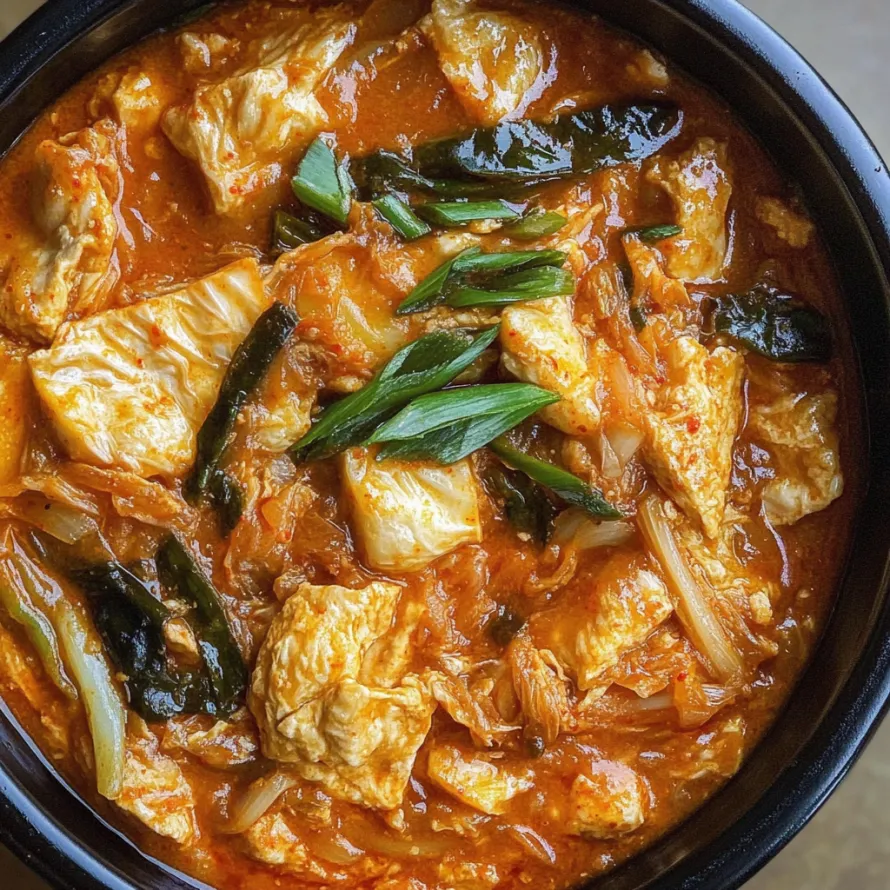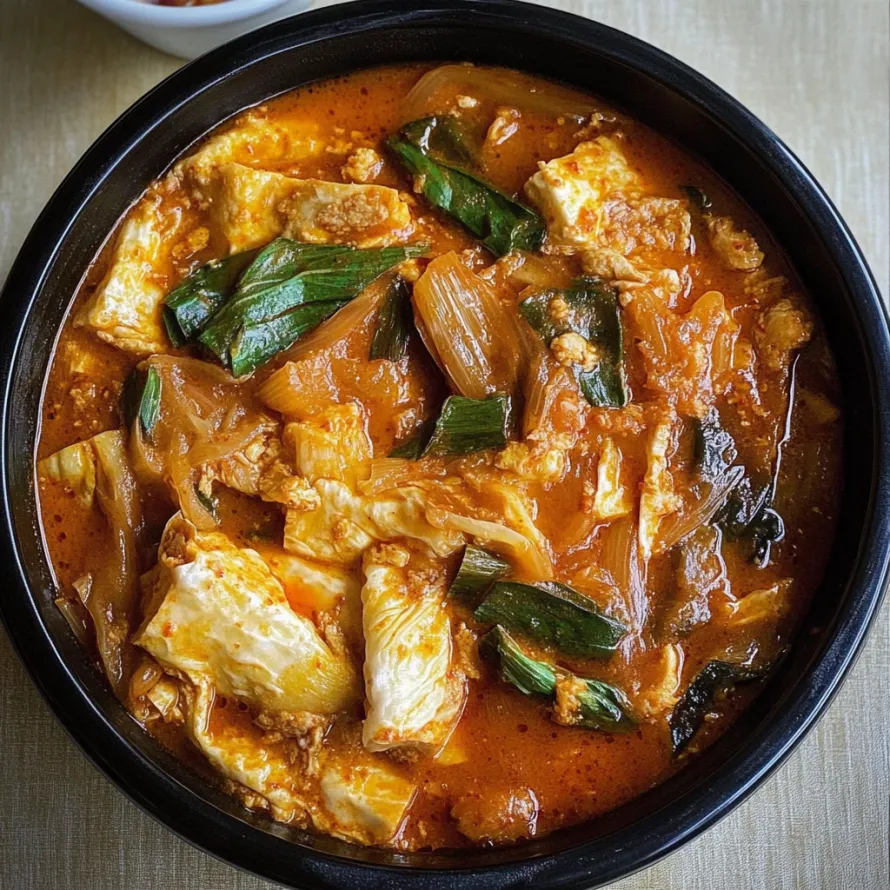 Pin it
Pin it
Ever tried kimchi jjigae (said like kimchi chigae)? It's basically the perfect way to use up kimchi that's gotten nice and sour. This famous Korean stew shows up on tables all over Korea multiple times a week - it's pretty much the definition of Korean comfort food. When you taste it, you'll get why. It wraps you up like a cozy blanket when it's cold outside. The sour kick from the fermented kimchi works magic with the rich broth and tender meat, making something that tastes way better than you'd expect.
I first tried kimchi jjigae back in my college days when my Korean roommate cooked it during an awful winter. The moment that red broth started bubbling, our whole apartment smelled amazing. I took one taste and right away understood why Koreans love this simple stew so much. Even now, years later, I think about that first bowl whenever I cook this for my family, especially when it gets cold and we want something that feels like a warm hug.
Key Ingredients
- Pork belly chunks: Add that needed fat richness that melts into the soup, making it silky in a way that leaner meats just can't match
- Fermented kimchi: Creates the main flavor with its natural tanginess that works perfectly with the fatty meat
- Mirin or sweet cooking wine: Softens the meat and brings a hidden layer of flavor to the background
- Black pepper: Adds a gentle warm spice that works with the other spicy elements without going overboard
- Yellow onion chunks: Slowly break down in the stew, adding natural sweetness that balances the sour kimchi
- Scallion bits: Bring a pop of fresh flavor and bright color when tossed in at the end
- Dried mushrooms: Give that deep savory taste while soaking up all the other flavors
- Tofu blocks: Create a nice texture change and extra protein while drinking up the tasty broth
- Gochugaru (red pepper flakes): Give that real Korean color and layered heat that makes it authentic
- Korean soy sauce: Grounds everything with that deep savory kick that's key in Korean cooking
- Hot pepper paste: Makes everything thicker and adds that complex fermented taste nothing else can give
When fatty pork belly meets tangy kimchi, they create something truly special. The tofu works like a sponge for all that yummy broth, while the mushrooms bring an earthy richness that ties everything together. Using the best ingredients you can find really matters here - it's what makes each spoonful burst with flavor and warmth.
Cooking Steps
- Getting the meat ready:
- First, slice your pork belly without skin into small, even bites about half an inch thick so they'll cook the same. Put the meat in a bowl and pour some sweet rice wine over it. Add a few twists of black pepper and mix it all up with your hands. Let it sit for 15 minutes while you work on everything else - this helps make the meat tender.
- Waking up the kimchi:
- While your meat sits, grab your aged kimchi and drain the juice into a bowl (don't throw it away!). Cut the kimchi into bite-sized pieces, using both the leafy parts and crunchy stems. Put a small pan on medium heat and toss in the kimchi with no oil. Cook it for about 5 minutes, stirring now and then until it gets soft and starts releasing its red oils. This step really brings out all the hidden flavors.
- Building your stew:
- Find a clay pot or heavy pot that holds at least 3 cups. Spread the pork pieces across the bottom to start your flavor base. Layer the cooked kimchi on top of the meat, spreading it out evenly. Add your sliced onions, mushroom pieces, and tofu chunks, arranging them so they look nice and will cook evenly. Pour in the saved kimchi juice and enough fresh water to mostly cover everything.
- Making the flavor mix:
- In a separate small bowl, mix together your Korean red pepper flakes, soy sauce, hot pepper paste, minced garlic, and more black pepper. Stir until you get a smooth paste. Dollop this mixture across the top of your stew ingredients - don't stir it in yet, just let it slowly melt in while cooking.
- Cooking it right:
- Put your pot over medium-high heat and let it come to a gentle boil without touching it - this lets all the flavors start mingling naturally. Once it's bubbling steadily, turn down the heat to keep it at a medium simmer and cook uncovered for 15 minutes. Every so often, spoon some broth over any ingredients sticking out. In the last couple minutes, throw your green onions on top and gently mix them in without stirring too much.
 Pin it
Pin it
Out of everything in this dish besides the kimchi, I really can't get enough of the gochujang paste. My grandma always used homemade stuff she fermented in old clay pots. Store-bought works great too, but sometimes I treat myself to fancy small-batch versions from Korean markets that remind me of sitting in her little kitchen in Seoul.
How To Serve It
Make your kimchi jjigae into a real Korean feast by adding some sides that go well with it. Start with a bowl of fluffy short-grain rice - it's perfect for soaking up that tasty broth and makes the meal filling. Add some simple side dishes like quick pickled cucumbers or spinach tossed with sesame oil for something fresh. Small portions of radish kimchi or fermented bean sprouts give you different textures and follow the traditional Korean meal setup.
Keeping Leftovers
Take care of any leftover stew so it stays safe to eat and actually gets even tastier over time. Let everything cool down completely before putting it in glass containers with tight lids instead of plastic ones that might stain red. Put it in the fridge right away and try to finish it within four days. You'll notice the flavors often get even better overnight as everything continues to blend together.
 Pin it
Pin it
This kimchi jjigae has stuck with me through every stage of life, from tiny college apartments to big family dinners where it always ends up stealing the show. There's something magical about what happens when sour kimchi meets juicy pork and classic Korean seasonings - it makes a dish that somehow connects people across generations through food traditions.
Frequently Asked Questions
- → Is fresh kimchi okay instead of aged?
- Aged kimchi (about 2-3 weeks old) gives the best taste, but fresh works too. Try adding a small splash of white vinegar or lemon juice to achieve that tangy bite.
- → How do I make a vegetarian option?
- Skip the pork and opt for vegetarian kimchi (no fish sauce). Load up on mushrooms or tofu, and a bit of vegetable oil can add richness.
- → What’s an alternative to gochujang?
- Mix 2 parts sriracha, 1 part miso paste, and a little sugar. It’s not the same but comes close in heat and flavor depth.
- → What sides go well with this dish?
- Serve with steamed rice or pair with Korean sides like bean sprouts (kongnamul), spiced cucumber (oi muchim), or braised potatoes (gamja jorim).
- → How long does it keep in the fridge?
- Store it in a sealed container for up to 3 days. The flavors actually get better as it sits overnight.
